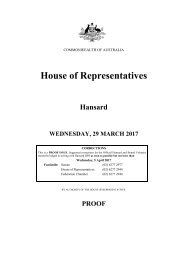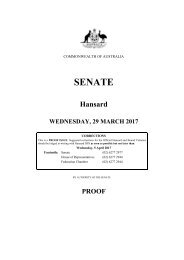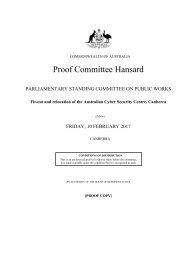SENATE
2mKfSKX
2mKfSKX
You also want an ePaper? Increase the reach of your titles
YUMPU automatically turns print PDFs into web optimized ePapers that Google loves.
Wednesday, 1 March 2017 Senate Page 17<br />
Defence numbers. I am particularly interested in some reported remarks that you have made on the question of<br />
contractors. In an article on 20 February in the Canberra Times it was reported that you said that the number of<br />
contracts is now outnumbering the Public Service workforce in the department. I am wondering if that is the case?<br />
Mr Richardson: No, it is not. That is an inaccurate report. The number of service providers plus contractors<br />
and consultants would outnumber public servants. There is nothing unusual in that. We only have an estimate of<br />
the number of people employed by service providers. With service providers, you enter into a contract for a<br />
particular service to be delivered, and the number of people who they employ to deliver that service is their<br />
business. We do not determine the number they employ. For instance, the garrison service contracts we have.<br />
That’s catering. Service providers include caterers and people who mow lawns. It is people who do the full range<br />
of looking after bases. The three areas in which most service providers deliver people are in the area of estate<br />
management, capability acquisition and sustainment, particularly in the maintenance and sustainment side of a<br />
house and, thirdly, in ICT. With consultants, again, you enter into a contract with a firm to do a particular job.<br />
The number of people they employ to do that job is their business. We do though the numbers of contractors. At<br />
the moment it is around 700.<br />
Senator KIM CARR: Has that changed in recent years?<br />
Mr Richardson: Yes, it has. The number of contractors has pretty much doubled in the last 12 months.<br />
Senator KIM CARR: How do you account for that?<br />
Mr Richardson: I am not entirely sure. Let me put it in context. Any suggestion that APS goes down and<br />
contractor and other numbers automatically go up is just dead wrong. Let me put in context. As I mentioned in my<br />
opening comments, in the four years from late 2012 we downsized by about 5,000 people. You cost a public<br />
service in defence, including on-costs, utilities and the like, at approximately $125,000 per person. So 5,000<br />
people is roughly $625 million, I think. I would say that we have not taken all of that out of the cost structure of<br />
the organisation and fed back into capability. But I would say we have taken between 400 and 450—around about<br />
$400 million—out of our cost structure. The remaining $125 million has probably fed back into outsourcing, et<br />
cetera. So there would be an element of that in the increase in contract numbers.<br />
Senator KIM CARR: Thank you for that. I will put a series of questions on notice to get a breakdown of the<br />
changes. That will cover the issue rather than go through that level of detail. The article reported that you were<br />
considering capping the amount of money Defence could spend on consultants after the numbers nearly doubled<br />
in less than a year.<br />
Mr Richardson: No, contractors nearly doubled. I did not say that consultants nearly doubled.<br />
Senator KIM CARR: So that was just a mistake by the reporter?<br />
Mr Richardson: Well, I did not talk to the reporter, so whoever spoke to the reporter made a mistake.<br />
Senator KIM CARR: They got it wrong. Okay. Is it the case that you are intending to cap the amount of<br />
money that is available for contractors?<br />
Mr Richardson: No, for consultants. We can control contractors through numbers. With consultants, the best<br />
way to control it is through money. The Defence committee took a decision earlier this week to reduce the money<br />
available to consultants from 1 July this year–that is, next financial year–by 10 per cent.<br />
Senator KIM CARR: About how much is that?<br />
Mr Richardson: I would need to take that on notice.<br />
Senator KIM CARR: Are there any further actions being taken in regard to consultants?<br />
Mr Richardson: We will control consultants through the allocation of monies.<br />
Senator KIM CARR: But the question of public service capability is a long-standing issue within the APS. Is<br />
it your view that the department's capabilities have been run-down where you actually have to employ consultants<br />
for work that has traditionally been done by public servants?<br />
Mr Richardson: There would be limited instances of that, but it is not systemic.<br />
Senator KIM CARR: What sort of instances?<br />
Mr Richardson: Clearly, if you reduce your workforce by over 22 per cent that does have an impact on what<br />
you can and cannot do. So inevitably there would be some instances where we would have engaged consultants<br />
where previously we might not have had to do so.<br />
Senator KIM CARR: It has been my experience in other portfolios that they have had a reduction in public<br />
service numbers and an increase in the number of consultants. Often the consultants fees are undertaken by expublic<br />
servants at higher rates. Is that the case in Defence?<br />
FOREIGN AFFAIRS, DEFENCE AND TRADE LEGISLATION COMMITTEE















